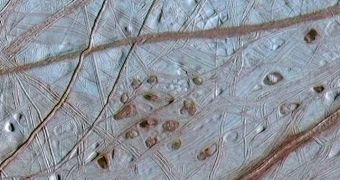Jupiter's moon Europa is undoubtedly one of the most interesting celestial bodies in the solar system, right alongside Titan and Enceladus, natural satellites of Saturn. This space rock is believed to be covered in an icy cap that may very well be hiding a liquid ocean of water underneath. Cracks in the surface of these caps contain sulfur-rich materials that researchers believe could shed some light on the composition of what's below the ices. In order to get a better understanding of this, astronomers are now turning to the Arctic, which they plan to use a “simulator” for Europa, Space reports.
The biggest assumption that experts are making is that the sulfur-rich materials on the surface of the moon may be containing organic matter that was drawn upwards from within the moon. If that is indeed the case, then early forms of life may have developed inside Europa's liquid oceans, and this would be tremendously important for science.
“Europa's liquid water layer contains twice the volume of all the Earth's oceans combined, an enormous potentially habitable environment, not billions of years in the past but at the present day. The composition of the ocean directly controls our view of the habitability of the environment, our understanding of whether microbial life could survive there, and if so, what metabolic pathways or geochemical gradients it could utilize to gain energy,” says Damhnait Gleeson, an expert in astrobiology who works at the Pasadena, California-based NASA Jet Propulsion Laboratory (JPL).
While investigating the Canadian High Arctic for Earth-based equivalents to the conditions on the Jovian moon, the JPL team discovered such a rare combination of elements at Ellesmere Island. They were basically trying to find a place where sulfur-rich springs met glacial ice. In the Arctic, where spring comes late, and only lasts for a very short time, studying the interactions that appear in such ecosystems may hold the key to making more accurate predictions about what is going on millions of miles away, on Jupiter's orbit.
“These results represent the first data on the detection of sulfur minerals on ice in a terrestrial setting. These new data improve our ability to correctly identify these minerals in other locations. Technology under development for future missions could benefit from field-testing in this Europa-relevant environment,” the team leader adds.

 14 DAY TRIAL //
14 DAY TRIAL //